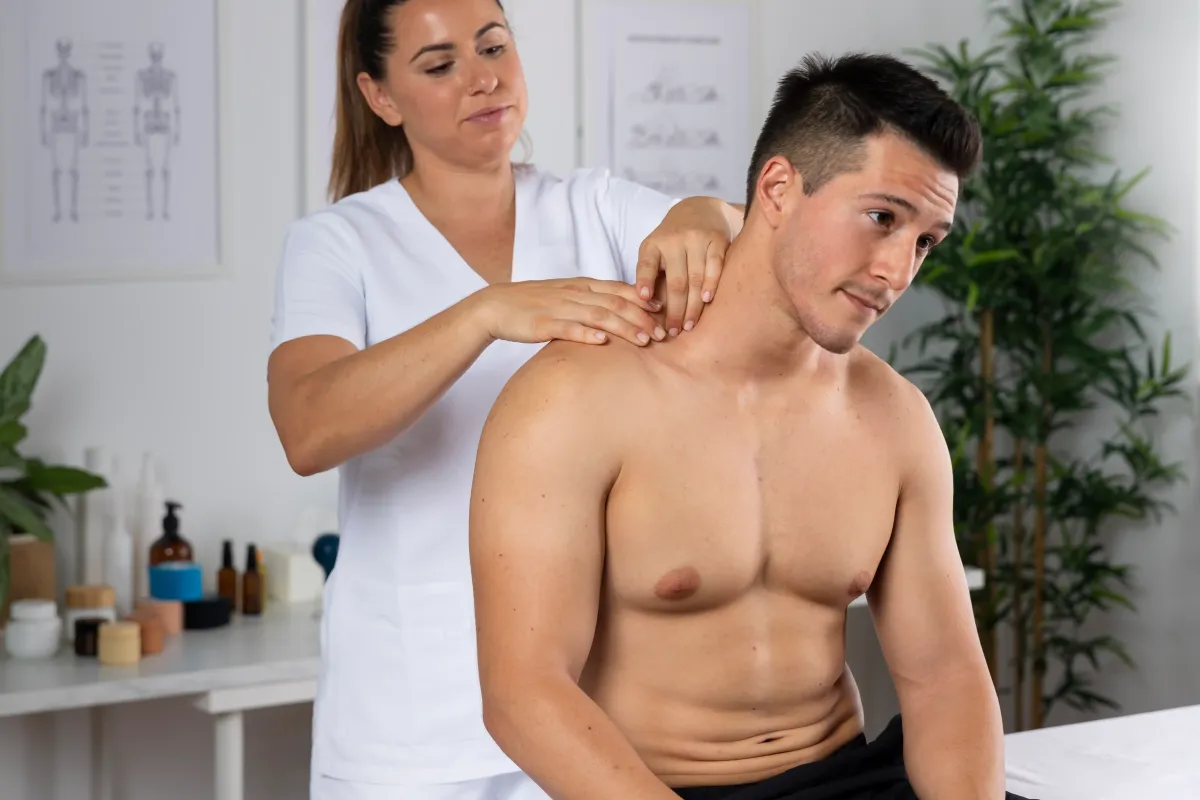Muscle Scraping Therapy in NYC
Manhattan Physical Therapy

What Is Muscle Scraping Therapy?
Muscle scraping therapy — also known in the clinic as Instrument Assisted Soft Tissue Mobilization (IASTM) — is a manual-therapy technique designed to release tight or restricted soft tissues using specialized tools. Instead of relying solely on hands, a trained therapist uses a smooth-edged tool (often stainless steel) to glide over muscles, fascia, tendons, or scar tissue. The goal is to identify areas of tension or adhesion, apply gentle but firm strokes, and thereby restore normal tissue movement and function.
Mechanically, the scraping process produces a controlled stimulus in the soft tissue. That stimulus can promote increased micro-circulation, improved soft tissue glide, and may help remodel collagen in areas of old injury or scar formation. While research is still evolving, many clinical practices report faster improvements in mobility and reductions in pain when this technique is employed alongside traditional physical therapy.
How Does Muscle Scraping Work?
The scraping motion creates controlled microtrauma at the skin’s surface, which signals your body to start a localized healing response. This triggers the production of collagen and elastin, improves microcirculation, and helps break down fibrous adhesions within the soft tissue. The result is increased mobility and reduced stiffness in the affected area.
While some mild redness or light bruising can occur, this reaction is part of the body’s natural healing process. Studies suggest that IASTM may enhance blood flow, reduce inflammation, and encourage tissue remodeling — all of which support long-term recovery when integrated into a structured rehabilitation plan.
Our therapists combine muscle scraping with therapeutic exercise, stretching, and joint mobilization to ensure you get both short-term relief and lasting results.
What Conditions Can Muscle Scraping Help With?
Muscle scraping therapy can help relieve pain, improve mobility, and restore healthy tissue function in a variety of musculoskeletal conditions. It works by reducing fascial restrictions, improving circulation, and stimulating the body’s natural healing response. At our clinic, this technique is often incorporated into individualized treatment plans for the following conditions:
Plantar Fasciitis
This common foot condition involves inflammation of the thick band of tissue along the sole of the foot. Muscle scraping helps loosen tight fascia in the heel and arch, reducing pain and stiffness. When paired with stretching and manual therapy, patients often notice improved walking comfort and faster recovery.
Tennis Elbow (Lateral Epicondylitis)
Muscle scraping can effectively break down scar tissue and adhesions in the forearm muscles responsible for gripping and wrist extension. This restores smoother muscle glide, reduces tension, and enhances flexibility — crucial for athletes and professionals who use repetitive arm motions.
Carpal Tunnel Syndrome
In many cases, tightness in the forearm muscles and fascia contributes to nerve irritation in the wrist. Muscle scraping can help release these restrictions, improving circulation and reducing pressure on the median nerve. Combined with ergonomic corrections and nerve gliding exercises, it can help alleviate symptoms like tingling and numbness.
Shin Splints
Repetitive running or jumping can lead to inflammation along the shinbone. Muscle scraping increases local blood flow, helps release tension in the lower-leg muscles, and promotes recovery from microtears — all essential for active individuals or runners returning from overuse injuries.
Shoulder Impingement
Scar tissue and tight fascia around the rotator cuff can limit shoulder mobility and cause impingement pain. Scraping techniques help restore muscle glide and joint mechanics, allowing for more efficient rehabilitation when combined with strengthening and posture correction.
Post-Surgical Scar Tissue
After surgery, the body forms scar tissue that may restrict movement. Gentle muscle scraping helps remodel these tissues, promoting smoother motion and reducing stiffness. It’s particularly useful for knee, shoulder, or ankle surgeries during the later stages of rehab.
Benefits of Muscle Scraping Therapy
When integrated into a comprehensive rehabilitation program, muscle scraping offers a range of proven benefits for patients dealing with muscle tension, restricted mobility, or chronic pain:
Improved circulation and tissue health
The technique boosts local blood flow and lymphatic drainage, helping supply oxygen and nutrients to the muscles while removing metabolic waste. This promotes faster recovery and tissue repair.
Reduced pain and muscle tightness
By breaking down adhesions and releasing fascial restrictions, scraping relieves pressure in affected muscles and decreases stiffness and soreness. Patients often feel an immediate sense of relief and lighter movement.
Enhanced flexibility and range of motion
Improved tissue glide allows joints and muscles to move more freely. This is especially beneficial for athletes or individuals returning to activity after injury.
Faster recovery from overuse or injury
The therapy can reactivate healing in tissues affected by repetitive stress or old injuries. When paired with strength training and corrective exercise, it supports faster, more complete rehabilitation.
Support for both athletes and everyday patients
While commonly used by runners, weightlifters, and CrossFit enthusiasts, the therapy benefits anyone struggling with movement restrictions from daily strain, poor posture, or sedentary habits.
What to Expect During a Session
During your first session at Manhattan Physical Therapy, your therapist will begin with a detailed assessment of your symptoms, medical history, and movement patterns. This helps determine whether muscle scraping is appropriate for your condition or if another treatment method would be more effective.
The scraping procedure itself is straightforward and typically lasts between 10 and 20 minutes. After applying a small amount of lotion or oil to reduce friction, the therapist uses a specialized stainless-steel tool to glide across targeted muscle groups. You might feel a firm but tolerable pressure, followed by a mild warmth or redness in the area — a sign of increased circulation.
Is Muscle Scraping Safe?
When performed by a qualified physical therapist, muscle scraping is considered a safe and effective soft tissue technique. The most common aftereffects are mild redness or light bruising that typically fades within a few days. These reactions are part of the normal healing process as your body increases blood flow to the treated area.
However, muscle scraping should always be performed under professional supervision. Improper technique or excessive pressure can cause unnecessary irritation or skin sensitivity. Patients with certain conditions — such as open wounds, varicose veins, or blood-clotting disorders — should inform their therapist beforehand.
If you’re searching for muscle scraping therapy in NYC, our experienced team at Manhattan Physical Therapy is here to help you recover faster and move better.
Call (212)-213-3480 to schedule your appointment today or visit our clinic in Midtown Manhattan to discover how professional physical therapy can make a difference.
What others are saying
Alexander Liu
"Everyone on the team at Manhattan Physical Therapy is super nice and caring. They were able to pretty quickly diagnose my knee and hip problems and immediately put me to work to reduce the pain.."
Henry Myerberg
"You're not just a patient when you come to the Manhattan Physical Therapy. You feel like family there. In particular, Erica with her colleagues John, Lidia and Joe not only fix and improve you physically, they make you feel welcomed and cared for.."
Hakyung Kim
"Everyone is so kind and helpful! my knee and hip pain have improved massively since starting Manhattan PT, highly recommend to anyone. special thanks to Bianca, Lidia, Joe, and John!"
Manhattan Physical Therapy
✆ Phone (appointments):
(212) 213-3480
Address: 385 5th Ave, Suite 503, New York, NY 10016

